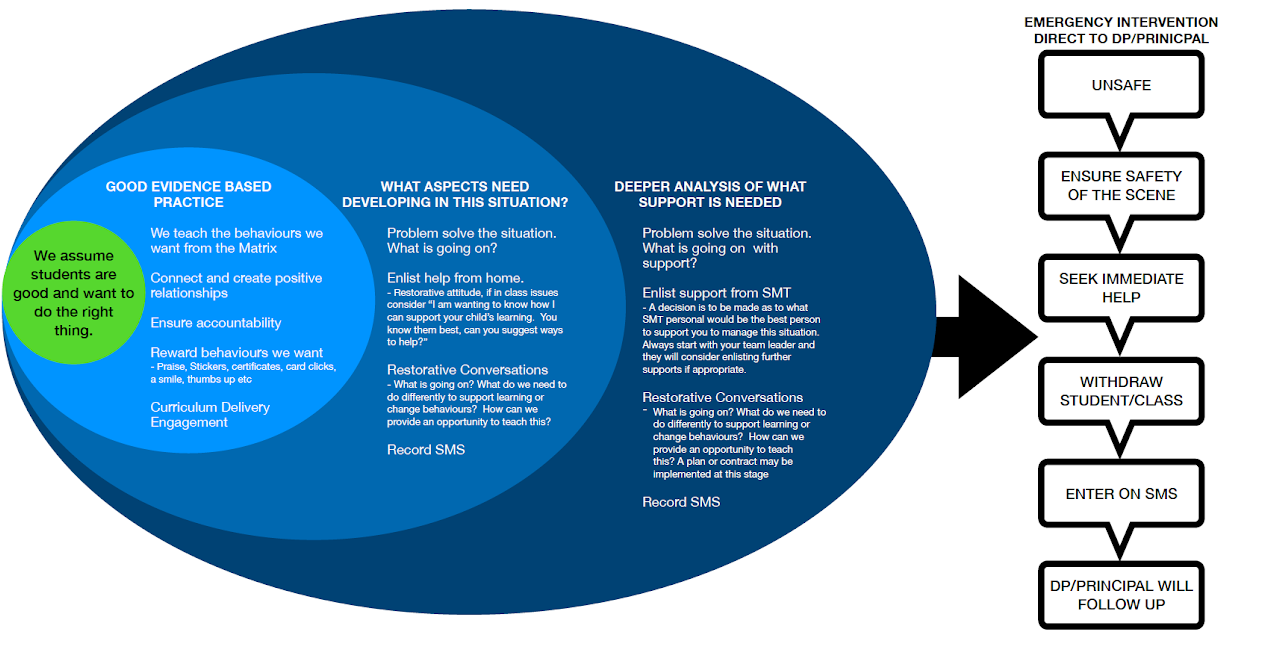Ashhurst School Behaviour Model

Above is the implementation of the behavioural model for Ashhurst School. As a school we always assume that students are good and are wanting to do the right thing. Most of the time the staff at Ashhurst School will be working within the light blue circle. As behaviours may escalate staff will respond by increasing the levels of support, as needed. Below is material that supports how staff should address, both positive and negative behaviour and some guides on suggestions.
As we work our way through potential issues it is important that we consider a restorative approach. Restorative practice is where "a relational approach to school life grounded in beliefs about fairness, dignity, mana and the potential of all people" (PB4L Kete, Book 1)
We also consider the four underlying principles that
- positive interpersonal relationships are a major influence on behaviour
- a culture of care supports the mana of all individuals in the school community
- cultural responsiveness is key to creating learning communities of mutual respect and inclusion
- a restorative approach leads to individuals taking responsibility for their behaviour. (PB4L Kete, Book 1)
Throughout the model, support is to be provided to all staff. Staff should not be left to deal with issues individually. The purpose of this model is to recognise when further supports are required to assist both the student and the classroom teacher to reinforce or modify the behaviour of students at Ashhurst School.
Sky - Intervention
PB4L Implementation
Ashhurst School is currently a Tier 1 PB4L School-Wide school. The implementation of PB4L at Ashhurst school has been a process of reflection, consultation, and collaboration with staff, tamariki, and whānau. The Ashhurst School PB4L Matrix aligns with our school values and highlights the expectations we believe are essential for our tamariki, staff, and community. It provides the basis for
ASHHURST SCHOOL PB4L-SW PURPOSE STATEMENT
PB4L School-Wide enables schools to build a culture where positive behaviour and learning is a way of life. PB4L School-Wide is about creating a positive environment by utilising systems, practices, and philosophies to support our learning community.
PB4L School-Wide takes the approach that opportunities for learning and achievement increase when we:
• maintain a positive, respectful and safe learning environment
• expected behaviours are explicitly taught, modelled and acknowledged
• positive relationships are fostered by responding fairly and equitably
What PB4L looks like at Ashhurst School
- PB4L School Matrix: The Ashhurst School Matrix has been developed and refined over the past 2 years. The matrix
- PB4L Lesson Plans: Lesson plans are created by teachers and teams and link to the PB4L matrix and our school values. They are used to explicitly teach and reinforce the positive behaviour we believe are important at Ashhurst School. Lesson plans are created by teams and are tailored to meet the needs of the tamariki within their team. Teachers have the autonomy to choose what they teach based on the needs of the children within the team or class
- Classroom Problem Solving: Each teaching team has a representative in the PB4L Hub. Teams are required to allocate a time slot for PB4L within their team meeting (fortnightly) to discuss anything related to PB4L. This is also the time where teachers can engage in the Classroom Problem Solving process to help with any challenging behaviours they might be facing. This is facilitated by the PB4L representative.
- Active Supervision: Staff on duty are expected to follow "Active Supervision" guidelines. They wear hi vis vests so they are visible, move in a random patterns, target areas of concern, and aim to have a number of brief, positive engagement with tamariki.
- PB4L Hub: The PB4L Hub is made up from teachers from each teaching team, office staff, teacher aids, and senior management. The hub meets twice termly to discuss rewards days, analyse data, organise reward days, and check in
- PB4L behaviour data analysis and data sharing: Data is a key element of PB4L. Data is entered onto etap
- Sterling and Reward Days: Children are recognised for the
- Assembly - Sterling or the Bag
- Certificates and Bands:
- Positive Praise
PB4L
Flipped Learning Pedagogy
- Building Positive Relationships:
- Engaging Learning:
- Turning is Learning:
Minor or Major Behaviours
There are multiple factors to consider in behavioural issues. Circumstances around, and impacts on, an individual need to be considered. Other factors may be whether both parties were part of the incident and consented, only one person instigating the issue and other parties were unwilling participants, and the age of the students involved. Below are the definitions of what we consider to be a major or minor behaviour. These definitions are then matched against the school matrices. A minor behaviour is escalated to a major behaviour when the minor behaviour is repeated multiple times, even after intervention.
Minor Behaviour - Royal
A royal intervention is when a student has been deemed to have acted in a way defined as a "minor" behaviour towards another student. The classroom teacher deals with this situation. The classroom teacher will focus on using the restorative chat (2 min talk) with the student to ensure that learning has taken place about the harm caused and agreed steps to "repair the harm". Reaching an agreement should be simple and relate to the issue raised. This may possibly be followed up with communication to home to enlist support from parents .
This information is recorded in the school SMS system for PB4L. Parents may be contacted.
Where a student contravenes the behavioural expectations of the Ashhurst School PB4L matrix.
Examples of this are but not limited to..
- Two students arguing about a ball at lunchtime -
- A student who does not complete learning in class
- Children using inappropriate language
- Very minor altercation where children get frustrated with each other (no previous history)
- Minor theft of items (first time)
- Minor throwing of a ball at each other
- Not sharing equipment
In all these cases a conversation with the children to resolve the issue is appropriate and then a follow up call from their teacher to ensure the messaging home is clear. Many of these incidents can be simply resolved with an apology and teaching of alternative strategies will be enough. If this happens at play time breaks, the duty teacher can touch base with the classroom teacher and inform them to contact parents with an update.
Major Behaviour - Navy
A navy intervention is when a student has been deemed to have acted in a way defined as a "major" behaviour towards another student. The classroom teacher seeks support firstly from their team leader. A plan may be decided between the classroom teacher and the team leader on how to manage this situation. This plan would then be entered on eTAP. If some of these behaviours have escalated, further support from the Deputy Principals or Principal is sought. It will be the role of the SMT, to provide support such as speaking with the affected students, provide support when speaking to or meeting parents and also developing plans and implementing these to ensure that the requirements of the "follow up" are met with the classroom teacher.
There may be occasions when the Team Leader may refer this to the Deputy Principal or Principal and the issue may be escalated to requiring emergency intervention.
In the event of the Team Leader being unavailable, then the teacher can directly speak with SMT.
This information is recorded in the school SMS system with both a PB4L entry and also a follow-up entry with what the planned outcome was going to be. Parents should be contacted and may need to meet to discuss the planned actions
Where a student puts themselves at risk or may cause significant physical or emotional harm to another student. It will also be considered to be a major where students defy staff or are physical towards a member of staff.
Examples of this are but not limited to..
- A repeated minor behaviour
- A student picks on another student in the playground, physically hitting that person because they did not play by his/her rules. There is a power imbalance between the students.
- Cyber bullying at school
- Vaping/Smoking
- Vandalising property
- Harassment
- Defying the instructions of any staff member
In all these cases a conversation with the children to resolve the issue is not significant enough. The team leader or SMT may be requested to be part of the process to assist with developing a plan to assist the child, repair harm or consider further repercussions such as stand down or suspension. The team leader will work with the classroom teacher to decide on the appropriate restorative process or seek further assistance from SMT if they believe it needs to be escalated. When senior management is required to take the lead, then the classroom teacher and Team leader will hand over and be informed of the outcome.
In all situations consider the question, "If it was your child at another school, who as a parent do you think it is appropriate to hear from to resolve the issue?"
Emergency Intervention
An emergency intervention is required when a situation puts the welfare of students or staff at serious risk of physical and/or emotional harm. At this stage it is important to consider the immediate safety of students and staff and take actions to ensure the safety of all involved.
Above is a flow chart that indicates the steps and procedures within the behavioural model.
Possible outcomes may include stand down or suspension. Some of the actions would meet the following criteria.
Definitions
Stand-down means the formal removal of a student from school for a specified period. Stand-downs of a particular student can total no more than five school days in a term or ten school days in a year.
Suspension means the formal removal of a student from school until the board of trustees decides the outcome at a suspension meeting.
Under the education Act Section 14 1989, the principal may choose to stand down or suspend a child under the following
(1) The principal of a state school may stand-down or suspend a student if satisfied on reasonable grounds that –
(a) The student’s gross misconduct or continual disobedience is a harmful or dangerous example to other students at the school;
or (b) Because of the student’s behaviour, it is likely that the student, or other students at the school, will be seriously harmed if the student is not stood-down or suspended
Through this process to make a decision the principal will ensure that all principles of natural justice are upheld.
Natural Justice means you must act fairly in the circumstances. Common expectations are that a person will have adequate notice of a situation that may affect them, they will have an opportunity to be heard and respond, and that a decision will be made by an unbiased decision maker.
If the issue is not deemed to fit this criteria once an investigation has taken place, then we will redirect the issue to the royal stage. Here the principal or deputy principal may still be involved in creating or constructing a IBP (Individual Behaviour Plan or Contract) for the student and family.
Supporters and Sponsors
Parents, please support our local businesses













Call Direct
Send Email
Visit Website

Call Direct
Send Email
Visit Website

Call Direct
Send Email
Visit Website

Send Email
Visit Website

Call Direct
Send Email

Call Direct
Send Email
Visit Website

Call Direct
Send Email
Visit Website

Call Direct
Send Email
Visit Website

Call Direct
Send Email

Call Direct
Send Email
Visit Website

Call Direct

Call Direct
Send Email
Visit Website
